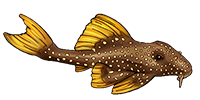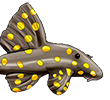Hisonotus notatus bred... now what?
Hisonotus notatus bred... now what?
Hello everybody,
at last I managed breeding my Hisonotus notatus... and I'd dare say that that was the easiest part! Now that the fry is free swimming I wonder how to raise them the best possible way. I realize this is not a precise science so any help will be very much appreciated. I am currently keeping part of the fry (those I could previously remove as eggs) in a hatchery inside the main tank. The rest of them is in the main tank with the adults which have never shown any interest in preying the eggs nor the newly hatched fry. Of course the water quality is key and I try to keep it optimal through daily water changes with RO water (up to 50% of the volume of the 72l tank!), but what I am really concerned about is the food. Bbs seems to be too big for the fry while infusoria tend to stay in the water column, too far and away from their mouths. Shall I give microworms a try?
Well, this is it for the moment. Hope to get some guidance please.
Furetto
PS. Here's some pics from day 1
at last I managed breeding my Hisonotus notatus... and I'd dare say that that was the easiest part! Now that the fry is free swimming I wonder how to raise them the best possible way. I realize this is not a precise science so any help will be very much appreciated. I am currently keeping part of the fry (those I could previously remove as eggs) in a hatchery inside the main tank. The rest of them is in the main tank with the adults which have never shown any interest in preying the eggs nor the newly hatched fry. Of course the water quality is key and I try to keep it optimal through daily water changes with RO water (up to 50% of the volume of the 72l tank!), but what I am really concerned about is the food. Bbs seems to be too big for the fry while infusoria tend to stay in the water column, too far and away from their mouths. Shall I give microworms a try?
Well, this is it for the moment. Hope to get some guidance please.
Furetto
PS. Here's some pics from day 1
Re: Hisonotus notatus bred... now what?
Day 2 - fry start showing some markings. Zero casualties. Team A (those removed from the main tank) is now free in a 50l tank alongside some 2 weeks old Apistogramma panduro and some Normann's lampeye Aplocheilychthys normanni the same age. How this will work out, honestly IDK, but they are been fed twice a day with bbs, microworms, infusoria and some powdered fry food. Daily water changes are regular at 50% with RO water.
Team B is somehow surviving in the main tank, feeding on what I assume to be some kind of microfauna. I forgot to mention that in the same tank I also keep a dozen of Neocaridina which, coincidently or not, have just doubled its numbers... although I doubt a baby Neocaridina could ever fit a Hisonotus fry' s mouth.
Here's what I could do with my camera...
Team B is somehow surviving in the main tank, feeding on what I assume to be some kind of microfauna. I forgot to mention that in the same tank I also keep a dozen of Neocaridina which, coincidently or not, have just doubled its numbers... although I doubt a baby Neocaridina could ever fit a Hisonotus fry' s mouth.
Here's what I could do with my camera...
- fishguy1978
- Posts: 492
- Joined: 24 Apr 2020, 18:57
- My cats species list: 31 (i:26, k:5)
- My aquaria list: 13 (i:12)
- My BLogs: 2 (i:1, p:53)
- My Wishlist: 1
- Spotted: 36
- Location 1: Puget Sound
- Location 2: WA
- Interests: Fish. I have multiple aquariums with fish from S.A, C.A., Africa, and Asia.
- Contact:
Re: Hisonotus notatus bred... now what?
Very cool. Keep the updates coming.
Did you say “CATFISH!?” I’m in.
-
Bas Pels
- Posts: 2918
- Joined: 21 Dec 2006, 20:35
- My images: 1
- My cats species list: 28 (i:0, k:0)
- Spotted: 8
- Location 1: the Netherlands
- Location 2: Nijmegen the Netherlands
- Interests: Central American and Uruguayan fishes
Re: Hisonotus notatus bred... now what?
With regard to your question - what to feed them? I think they would prefer algae, just as their parents do.
Presenting them algae might be hard, but I'd be surprised if they would eat anything else.
Presenting them algae might be hard, but I'd be surprised if they would eat anything else.
cats have whiskers
Re: Hisonotus notatus bred... now what?
Indeed! Gotta find a way to make them graze on algae though... and at this point other questions arise: is there any special kind of algae, how can I grow my own periphyton/biofilm at home, shall any green veggie work for the fry as well (I feed kale to the parents and they seem to like it)?
- fishguy1978
- Posts: 492
- Joined: 24 Apr 2020, 18:57
- My cats species list: 31 (i:26, k:5)
- My aquaria list: 13 (i:12)
- My BLogs: 2 (i:1, p:53)
- My Wishlist: 1
- Spotted: 36
- Location 1: Puget Sound
- Location 2: WA
- Interests: Fish. I have multiple aquariums with fish from S.A, C.A., Africa, and Asia.
- Contact:
Re: Hisonotus notatus bred... now what?
I feed dried seaweed from my local Asian market. Fluvial Bug Bites pleco, Sera wood chips, repashy morning wood, zucchini, yams, or carrots.
Did you say “CATFISH!?” I’m in.
Re: Hisonotus notatus bred... now what?
Thank you for the tips… will try seaweed asap!
Re: Hisonotus notatus bred... now what?
Day 4 - Skipped day 3 because, of course, I thought everything was lost... well, it was not! In time, all the fry moved to the raising tank have vanished, most likely perished. But, although I spent hours searching for any sign of them in the main tank yesterday and was ready to give up on them, today I found 3 little ones jumping from window to window. It's hard to focus the camera on them, because of their restless activity, but when I finally get it, it's a joy to see how they're well developing. I can only assume that there's just plenty of (right) food in the main tank and perhaps I shouldn't have moved the eggs in the first place. Anyway, let's wait and see how these little Hisonotus will keep growing in the same tank of their parents.
Re: Hisonotus notatus bred... now what?
Day 5 - Fry tend to stay near the outflow of the filter, why? I think that's because where there's more water movement there's more oxygen dissolved. Is this a rheophilic species? Adults stay mostly amidst vegetation, but this can be a non natural behavior due to the lack of space...
Will definitely look for something more accurate about its biology, but for the time being this is what I found on the net:
https://doi.org/10.1590/1982-0224-20150100
And those are pictures of day 5 fry!
Will definitely look for something more accurate about its biology, but for the time being this is what I found on the net:
https://doi.org/10.1590/1982-0224-20150100
And those are pictures of day 5 fry!
Re: Hisonotus notatus bred... now what?
Day 7 - My fishes spawned again. The tank is full of eggs and I can't find any of the older fry. I guess it'll be all over again... I am posting here, should any news come in the future.
Re: Hisonotus notatus bred... now what?
Hi everyone, today my Hisonotus gang spawned again for the third time this month. This time I am managing to raise the latest offspring as well. What did I do differently from the fist time? I fed an organic kale leaf every single day. I had joined some facebook expertise group and figured out that my fry were dying from what they call insufficient food density... pretty bad right? Turns out I am not able of moving the fry to a different, smaller tank after they hatched, so I simply increased food disposability and prayed for the little ones to find it before starving to death. Must say that it is currently working. Oh, and I am not madly obsessed with water changes anymore. I wait two or three days before partially change it (25% on average). Maybe - and I am only presuming this - this species is not as sensitive as previously thought to be, IDK




